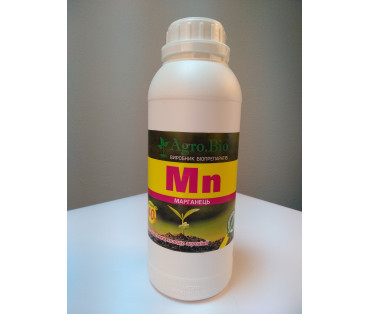Manganese (Mn) has the ability to be quickly digested by a plant and regulate the flow of other elements
Manganese (Mn) - is a trace element most necessary for plant nutrition after iron, its quantitative content in the plant is – 0,001%; it has the ability to be quickly digested by a plant, to move through its organs and regulate the flow of other elements; it affects growth processes, change of microbiological activity and the content of organic matter in agricultural crops; increases resistance to adverse factors, improves fruiting. Manganese takes an active part in the processes of photosynthesis (the transfer of electrons - due to the ability to change the chemical valence, the accumulation of chlorophyll, the formation of sugar, vitamins – ascorbic acid); of respiration (reduction of transpiration and increase of water-regulating ability, transfer of phosphorus from lower vegetative organs to the upper reproductive organs); of metabolism (carbohydrate metabolism, biosynthesis of proteins – amino acids, polypeptides, multi fractional proteins, etc.); of redox reactions; is a part of 10 groups of active enzymes (arginase, phosphotransferase, etc.).
Manganese deficiency: the insufficient manganese amount effects the formation of plastids and the process of photosynthesis; the plants are damaged by gray speck, their leaves become light green, the ratio of elements in the nutrition is deteriorated that leads to lethal yellowing, decline (small yellowish spots appear on leaves, that eventually lead to the extinction of their parts), to spotting of the roots; reduces frost resistance of agricultural plants. The most sensitive to the lack of the element: cereal crops (oats, barley) are damaged by gray speck, vegetable (spinach, beet) on which the spotted chlorosis is observed, legumes (beans, peas) – the seeds form black, brown spots, and fruit and berry crops (apple, peach) – various necrotic changes of leaflets, which further leads to a decrease or absence of fruiting. In most cases (for plants, if manganese is less than 10-25 mg / kg of dry weight) it leads to deficiency and manifests itself on soils after liming, at pH 6.0-6.5, at low temperatures, insufficient light intensity, high content of organic matter, in particular phosphorus and calcium.
Abuse of manganese nutrition: leads to a deficiency of iron in the soil. Yellow diseases appear on plants (on old leaves), spots of different colors (brownish black, necrotic) cover leaf blades and after a certain time leaves twist and fall; cereals suffer from wilting of crops. The manganese content exceeding in the soil should be controlled, in particular, plants should be fertilized with silicon, and the molybdenum eliminates the toxic effect of the element.
Manganese interinfluence with other elements
| Antagonists (overbalance of one triggers a deficiency of another element) | Synergist (improve mutual properties of each other) | Block the each other interaction (it is not recommended to combine together) |
| Fe (iron), Zn (zinc) | - | P (phosphorus), Ca (calcium) |
Related Products
Humat + Manganese «Agro.Bio»
Humat + Manganese of Agro.Bio ™ production - monochelatos, organic fertilizers, bezbalastnoe with leonardite, growth stimulants that provide complex nutrition for plants, in concentrated form, water-s..
$9.00
Humat + Manganese + Sulfur «Agro.Bio»
The preparation Humate + Manganese + Sulfur "Agrobio" combines the humate of potassium and Mn. This trace element is an active component of enzymes that are responsible for the processes of respiratio..
$12.00

